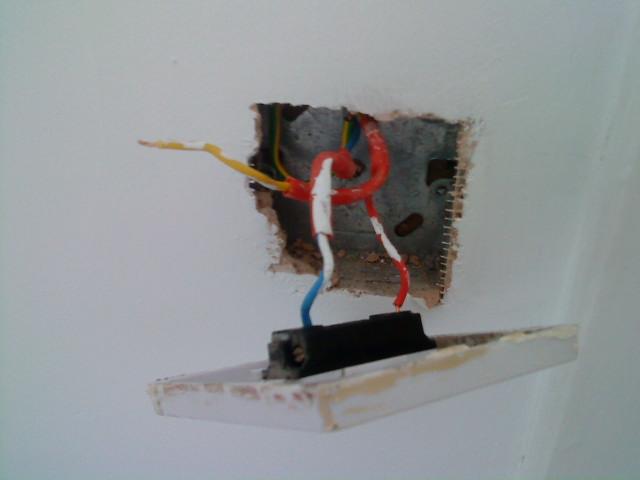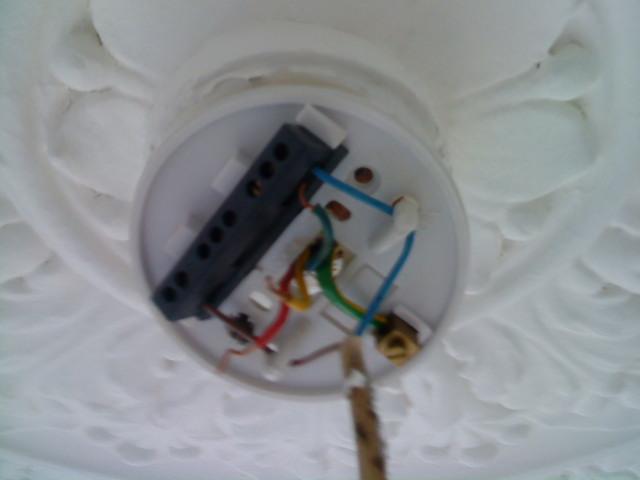Hi,
Have had a good look round the wiki and other threads and can't see anything that looks like this problem. Am struggling trying to figure out how the light in the front room we're renovating is wired up. It all worked, and then I got the "looks like there's a loose wire in the switch" call, and indeed one was flying loose. Now trying to work backwards to a way it will all work and need a better brain than mine to figure this out!
At the switch there is a single 3-core and earth cable, colours are red, yellow and blue. Red is in C, blue in L1 and yellow in L2. When I found it, the yellow was free, and others loose. Could have been in L2, or tied into L1 with the blue but please read on.
At the ceiling rose there is a single 3-core and earth cable, colours as above. There's also the usual blue and brown 2 core cable down to the actual bulb. The red and yellow are in the same connector block as the blue to the bulb, i.e all connected switched live. The blue is on the brown connector block, i.e. the neutral side.
With the help of a meter, the red at the switch is the live power, ok so far.
With the switch set so power is applied to blue, I can detect power on the yellow at the ceiling.
With the switch set so power is applied to yellow, I can detect power on the red at the ceiling.
With both the blue and yellow disconnected at the switch, no power detected at all at the ceiling rose.
At no point does the bulb light!
My current thinking, no pun intended, is whatever is hiding in the inaccessible junction boxes in the ceiling, it seems applying power to the switched live side of the ceiling rose, never causes the bulb to light, therefore the problem must be on the neutral side of the ceiling rose back somewhere up in those junction boxes.
Is there any other possible explanation please?
Lots about this is confusing me, such as, given there is only one switch, why would 3 core and earth be used anyway, at both ends of this? Also, this all worked, so how could all of sudden there be a problem on the return side of the circuit that doesn't go near the switch, it seems, and I'd hope!
Can anyone shed some light on this for me please? (ouch - not a pun either).
Thanks
Alan
Have had a good look round the wiki and other threads and can't see anything that looks like this problem. Am struggling trying to figure out how the light in the front room we're renovating is wired up. It all worked, and then I got the "looks like there's a loose wire in the switch" call, and indeed one was flying loose. Now trying to work backwards to a way it will all work and need a better brain than mine to figure this out!
At the switch there is a single 3-core and earth cable, colours are red, yellow and blue. Red is in C, blue in L1 and yellow in L2. When I found it, the yellow was free, and others loose. Could have been in L2, or tied into L1 with the blue but please read on.
At the ceiling rose there is a single 3-core and earth cable, colours as above. There's also the usual blue and brown 2 core cable down to the actual bulb. The red and yellow are in the same connector block as the blue to the bulb, i.e all connected switched live. The blue is on the brown connector block, i.e. the neutral side.
With the help of a meter, the red at the switch is the live power, ok so far.
With the switch set so power is applied to blue, I can detect power on the yellow at the ceiling.
With the switch set so power is applied to yellow, I can detect power on the red at the ceiling.
With both the blue and yellow disconnected at the switch, no power detected at all at the ceiling rose.
At no point does the bulb light!
My current thinking, no pun intended, is whatever is hiding in the inaccessible junction boxes in the ceiling, it seems applying power to the switched live side of the ceiling rose, never causes the bulb to light, therefore the problem must be on the neutral side of the ceiling rose back somewhere up in those junction boxes.
Is there any other possible explanation please?
Lots about this is confusing me, such as, given there is only one switch, why would 3 core and earth be used anyway, at both ends of this? Also, this all worked, so how could all of sudden there be a problem on the return side of the circuit that doesn't go near the switch, it seems, and I'd hope!
Can anyone shed some light on this for me please? (ouch - not a pun either).
Thanks
Alan



